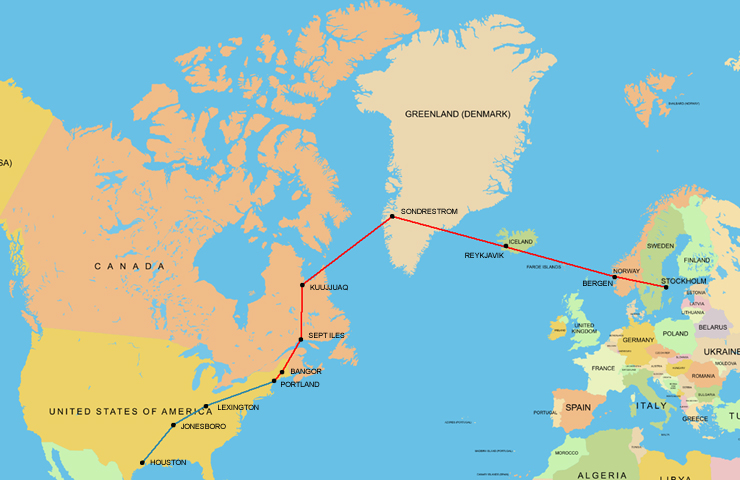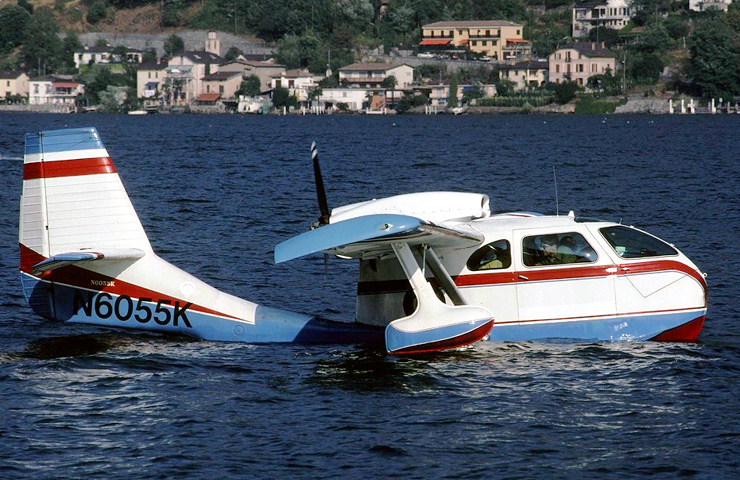|
N6055K
|
|
Delivery of Republic Seabee to Stockholm July 1991 Marc Gasporic, a Swiss pilot, and myself collected a Republic Seabee (N6055K) from RWJ Airport Houston Texas on July 20, 1991. The aircraft had been purchased by Mr. Jacobson, CEO of Colorant - a Swedish company. My nine year old son Douglas now an expert big mountain skier accompanied us on the short flight between RWJ and Hobby Airport Houston. Three days later Marc and I took off for Portland, Maine. We had planned refueling stops at Shreveport, LA, Jonesboro, Arkansas, and a night stop at Lexington, Kentucky. The Seabee had a three hundred horsepower Lycoming replacing the original Franklin engine. We had the standard avionics package plus a GPS. GPS in 1991 lacked two satellites so was not 100% accurate. High summer weather in the USA is hot with large build ups in the afternoons. We flight planned flying at eleven thousand feet and a speed of 140 knots. The flight to Shreveport was 1.50 hrs without incident in good weather. We estimated the flight to Jonesboro would be approximately 3.30 hrs, leaving us with the legal amount of fuel remaining. We approached Jonesboro in VFR conditions with Marc in the left seat. Downwind I selected gear down. Nothing happened! The main wheels remained firmly on the side of the fuselage. I reselected twice with no result. The area around Jonesboro has a number of reservoirs and small lakes. Marc and I decided to look for a lake near the airport - we were getting short of fuel... We flew over about three lakes, all with large tree stumps jutting out of the water large enough to rip the hull of the Seabee. Eventually we found a lake where there was a stretch of clear water alongside a dam. Unfortunately a couple had decided to fish out of their small boat in that area. After a swift consultation we decided that Marc should buzz the fishers in the hope that they would get out of our landing run. Realizing our intentions, the small boat hurriedly left the area. Marc made a very good landing and taxied to a boat ramp. About fifty yards from the ramp I realized that the aircraft was filling with water. We were sinking! Marc increased power, then we grounded short of the ramp. There was only one thing to do. I rolled up my pants and braving the water snakes I jumped into the water. I grabbed the mooring rope and pulled, eventually we beached the Seabee. A park ranger arrived. We had landed in a state park. He telephoned Jonesboro airport and asked them to send a mechanic. Meanwhile Marc and I were trying to drain a half full Seabee. Then the fisherman arrived. He had a large electric pump and he and his wife soon drained our water logged aircraft. After about an hour, a mechanic showed up. He found a ruptured hydraulic pipe. We had no hydraulic power when I had tried to lower the gear. The pipe repaired, the mechanic looked down into the hull. He asked us if we were familiar with the Seabee. We sheepishly told him we had flown it a couple of times. He told us that in the future it would be a good thing to check that the bilge drain chocks were closed before making a water landing. Marc and I brushed the egg off our faces. The Seabee was repaired, the drain cocks closed and now all we had to do was to fly the aircraft out of the lake. The clear strip of water we had landed on was out of the question. There were trees at either end. After taxiing avoiding the tree stumps and breaking up then glassy surface of the lake, there was no wind, we found a narrow passage clear of obstructions towards the low dam. Waving to the helpful fishers we took off. It seemed we were late getting up on the step but kept going and cleared the dam by a few feet. We agreed to avoid water landings for the rest of the trip. After a three hour flight we landed at Lexington Airport, parked the Seabee and found a motel for the night. Next morning we took off for a three hour flight to Portland, Maine, where we took the Seabee to a workshop to have an 80 gallon fuel tank installed in the rear of the cabin. I would leave the aircraft in Portland for three weeks while I flew a Cessna 404 to Düsseldorf and returned to the USA in a Cessna 421. Back in Portland I air tested the Seabee to check fuel was flowing from ferry tank to the main aircraft fuel tank. Marc had returned to Switzerland so now I was on my own for the trans Atlantic trip. Rather than fly the Azores route I chose to plan the northern route. I now had 9 hours endurance and as it was mid summer there would be few weather problems and a lot of daylight. Canadian regulations for single engine crossings stipulated a life raft, survival suite, pistol, drinking water and basic rations. On the northern route I did not need to carry an HF radio. On July 22, I took off early for a three hour flight to Sept Iles, Quebec province. After clearing customs into Canada and refueling I set off on a 7.30 hours flight to Kuujjuaq (Fort Chimo) Airfield situated on Ungava Bay, northern Quebec. It was hand flying all the way, the Seabee had no autopilot. The GPS worked on and off, but the weather was clear over the wasteland of northern Quebec. Forest, tundra and hundreds of lakes appeared as I left Labrador City, the last of civilization till arrival at Kuujjuaq, an Inuit settlement. There is an hotel in Kuujjuaq with reasonable food and clean rooms. After a good nights rest and a refueled Seabee I decided as the weather was good to fly direct to Sondrestrom, Greenland, cutting out a stop in Frobisher Bay, Baffin Island. The flight took six hours. All had gone well since Jonesboro and the engine had behaved perfectly. The tube connecting the pitot head and the airspeed indicator and altimeter passes down the left edge of the windscreen. Somehow on approach to Sondrestrom Airport it became detached. I suddenly had no altitude or airspeed indication. There was an ADF beacon at the far end end of runway listed on my airport chart with lat and long figures. Hoping the GPS was working, I patched the figures and got a ground speed reading. As there was little headwind and the runway is very long I had no difficulty in landing. I took a day off staying at the airport hotel. The temperature was in the upper fifties "F". Tourists who had come to view the ice cap and glaciers were sunbathing on the hotel balcony. The Seabee parked nearby caused interest, some saying they had never seen an aircraft like that before. One man asked if it would fly!! On July 25 I took off for the 750 mile flight to Reykjavik, Iceland. I have crossed the Greenland ice cap about ten times. From 30,000 feet in a jet it looks like a big snow field. From 11,000 feet in a small single engine it seems to last for ever. A very efficient US Air Force search and rescue flight of C-130s and Greenland Air helicopters based in Sondrestrom and Gothaab can in most cases rescued downed fliers. In good summer weather the crossing tho' somewhat lonely presents no problems. The minimum en route altitude published in the charts is 11,000 feet. With GPS, navigation is straight forward. Without GPS, dead reckoning and the possibility of receiving a very high wattage civilian radio station in Iceland is needed. The only object visible is the old DEW line wind battered radar dome known as "Sob Story" situated about half way across. There is one small airfield on the east Greenland coast at Kulusuk island for an emergency landing. The rest of the flight attention is required to monitor oil pressure and fuel state, there is no where else to land. The 300 hp Lycoming had little trouble in achieving 12,000 feet despite the 640 lbs of extra fuel. I landed at Reykjavik early in then evening. Next morning July 26 I took off for the longest leg of the ferry flight. Nine hours of hand flying is tiring and with most of the flight over ocean it was difficult to keep alert. Bergen Airport reported 3 miles visibility in haze. After landing I was greeted by Mr. Jacobson, the owner of the Seabee. Next day we flew to Stockholm, an eight hour flight. I landed in Stockholm harbor amongst the cruise liners. The harbor customs office was closed so we spent an uncomfortable night on the aircraft. Next day Mr. Jacobson damaged his arm pushing the aircraft away from a buoy. I took off alone for a small airstrip where the Seabee would be based. The end of an eventful flight. Robert (Bill) Evans |

| Date | From | To | Time | Remarks |
| 1991-07-21 | Portland, Maine | Bangor, Maine | 00:50 | |
| 1991-07-22 | Bangor, Maine | Sept Iles, Quebec, Canada | 03:00 | |
| 1991-07-22 | Sept Iles, Quebec, Canada | Kuujjuaq, Canada | 07:30 | |
| 1991-07-23 | Kuujjuaq, Canada | Sondrestrom, Greenland | 06:00 | |
| 1991-07-25 | Sondrestrom, Greenland | Reykjavik, Iceland | 05:20 | |
| 1991-07-26 | Reykjavik, Iceland | Bergen, Norway | 09:00 | |
| 1991-07-27 | Bergen, Norway | Stockholm Harbor, Sweden | 08:00 | |
| 1991-07-28 | Stockholm Harbor, Sweden | Stockholm Harbor, Sweden | ||
| 1991-07-29 | Stockholm Harbor, Sweden | Obi Jacobson's airstrip |
|
Seabee N6055K, s/n 230, was ferried to Sweden by Bill Evans for owner Obi Jacobson, CEO of Colorant Plast AB. Mr. Jacobson bought N6055K as a replacement for a Seabee that he bought in 1990, but was destroyed in a fire. Robert "Bill" Evans, (85) native Briton, is resident in Houston, Texas, USA. He served in RAF from 1942 until retiring in 1963. Then he flew for Axel Springer Verlag in Hamburg, Germany, piloting a Rockwell Jet Commander until 1970. 1970-1972 AeroLeasing, Geneva. 1972-1974 Israel Aircraft Industries, Israel/USA. 1976 Royal Jordanian Airlines (Arab Wings). 1977-1979 Mitsubishi Aircraft - European Sales Brussels. In 1980 he moved to the USA and started flying King Air 200 for Aerotron Aircraft Radio, California. 1982-1989 Merlin II and King Air 200 Los Angeles Engineering Company. In 1989 Bill started his own ferry flight business, Worldwide Ferry. He made 39 transatlantic crossings ferrying light twins and a few singles, the last in September 1994, just short of his 70th birthday. His last flight as a pilot was made on January 20, 1998. He then had accumulated a total flying time of 9,900 hrs, on 43 different aircraft types. Some of his memorable experiences include; rescuing a Mitsubishi MU2 from the then Zaire, a Beech Queen Air flight from Paraguay to San Antonio Texas, two months to deliver a Lake Turbo Renegade from Florida to Nairobi Kenya, 4 months as Idi Amin's pilot... Bill has a strong interest in the history of early Atlantic flights, after spending ten days in Sondrestrom waiting for a replacement generator for a vintage 1942 single engine Stinson Gullwing he was ferrying to France. |
